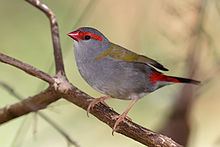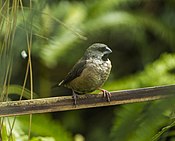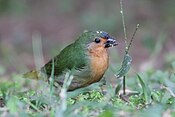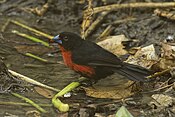Estrildidae
| Estrildidae | |
|---|---|

| |
| Red-browed finch, Neochmia temporalis | |
| Scientific classification | |
| Domain: | Eukaryota |
| Kingdom: | Animalia |
| Phylum: | Chordata |
| Class: | Aves |
| Order: | Passeriformes |
| Superfamily: | Passeroidea |
| Family: | Estrildidae Bonaparte, 1850 |
| Genera | |
Estrildidae, or estrildid finches, is a family of small seed-eating passerine birds of the Old World tropics and Australasia. They comprise species commonly known as munias, mannikins, firefinches, parrotfinches and waxbills. Despite the word "finch" being included in the common names of some species, they are not closely related to birds with this name in other families, such as the Fringillidae, Emberizidae or Passerellidae.
They are gregarious and often colonial seed eaters with short, thick, but pointed bills. They are all similar in structure and habits, but vary widely in plumage colours and patterns.
All estrildids build large, domed nests and lay five to ten white eggs. Many species build roost nests. Some of the firefinches and pytilias are hosts to the brood-parasitic indigobirds and whydahs, respectively.
Most are sensitive to cold and require warm, usually tropical, habitats, although a few, such as the eastern alpine mannikin, mountain firetail, red-browed finch, and the genus Stagonopleura, have adapted to the cooler climates of southern Australia and the highlands of New Guinea.
The smallest species of the family is the Shelley's oliveback (Nesocharis shelleyi) at a mere 8.3 cm (3.3 in), although the lightest species is the black-rumped waxbill (Estrilda troglodytes) at 6 g (0.21 oz). The largest species is the Java sparrow (Padda oryzivora) at 17 cm (6.7 in) and 25 g (0.88 oz).[1]
Taxonomy
[edit]The family Estrildidae was introduced in 1850 by the French naturalist Charles Lucien Bonaparte as "Estreldinae", a spelling variant of the subfamily name.[2][3] In the list of world birds maintained by Frank Gill, Pamela Rasmussen and David Donsker on behalf of the International Ornithological Committee (IOC) the family contains 140 species divided into 41 genera.[4] Molecular phylogenetic studies have shown the family Estrildidae is sister to the family Viduidae containing the indigobirds and whydahs. The two families diverged around 15.5 million year ago.[5] The most recent common ancestor of the Estrildidae is estimated to have lived around 10.9 million years ago.[6] A genetic study of the Estrildidae by Urban Olsson and Per Alström published in 2020 identified 6 major clades. The radiations within these clades occurred between 4.5 and 8.9 million years ago. The authors proposed that each of these clades should be treated as a subfamily.[6] This contrasts with an earlier proposal in which the family was divided into three subfamilies.[7]
| ||||||||||||||||||||||||||||||||||||||||||||||||||||||||||||||||||||||||||||||||||||||||||||||||||||||||||||||||||||||||||||||||||||||||||||||||||||||||||||||||||||||||||||||||||||||||||||||||||||||||||||||||||||||||||||||||||||
| Phylogeny based on a study of the Estrildidae by Urban Olsson and Per Alström published in 2020. The locust finch in the genus Paludipasser was not included in the study.[6] |
Genera list
[edit]| Image | Genus | Living species |
|---|---|---|
 |
Heteromunia Mathews, 1913 |
|
 |
Oreostruthus De Vis, 1898 |
|
 |
Stagonopleura Reichenbach, 1850 |
|
 |
Neochmia Gray, GR, 1849 |
|
 |
Emblema Gould, 1842 |
|
 |
Bathilda Reichenbach, 1862 |
|
 |
Aidemosyne Reichenbach, 1862 |
|
 |
Stizoptera Oberholser, 1899 |
|
 |
Taeniopygia Reichenbach, 1862 |
|
 |
Poephila Gould, 1842 |
|
 |
Spermestes Swainson, 1837 |
|
 |
Lepidopygia Reichenbach, 1862 |
|
 |
Euodice Reichenbach, 1862 |
|
 |
Padda Reichenbach, 1850 |
|
| Mayrimunia Wolters, 1949 |
| |
 |
Lonchura Sykes, 1832 |
|
 |
Chloebia Reichenbach, 1862 |
|
 |
Erythrura Swainson, 1837 |
|
 |
Nesocharis Alexander, 1903 |
|
 |
Coccopygia Reichenbach, 1862 |
|
 |
Mandingoa Hartert, E, 1919 |
|
 |
Cryptospiza Salvadori, 1884 |
|
 |
Parmoptila Cassin, 1859 |
|
 |
Nigrita Strickland, 1843 |
|
 |
Delacourella Wolters, 1949 |
|
 |
Brunhilda Reichenbach, 1862 |
|
 |
Glaucestrilda Roberts, 1922 |
|
 |
Estrilda Swainson, 1827 |
|
 |
Ortygospiza Sundevall, 1850 |
|
| Paludipasser Neave, 1909 |
| |
 |
Amadina Swainson, 1827 |
|
 |
Amandava Blyth, 1836 |
|
 |
Granatina Sharpe, 1890 |
|
 |
Uraeginthus Cabanis, 1851 |
|
 |
Spermophaga Swainson, 1837 |
|
 |
Pyrenestes Swainson, 1837 |
|
 |
Pytilia Swainson, 1837 |
|
 |
Euschistospiza Wolters, 1943 |
|
 |
Hypargos Reichenbach, 1862 |
|
 |
Clytospiza Shelley, 1896 |
|
 |
Lagonosticta Cabanis, 1851 |
|
References
[edit]- ^ "Estrildid FINCHes".
- ^ Bonaparte, Charles Lucien (1850). Conspectus Generum Avium (in Latin). Vol. 1. Leiden: E.J. Brill. p. 450.
- ^ Bock, Walter J. (1994). History and Nomenclature of Avian Family-Group Names. Bulletin of the American Museum of Natural History. Vol. 222. New York: American Museum of Natural History. pp. 117, 156, 218, 228. hdl:2246/830.
- ^ Gill, Frank; Donsker, David; Rasmussen, Pamela, eds. (July 2023). "Waxbills, parrotfinches, munias, whydahs, Olive Warbler, accentors, pipits". IOC World Bird List Version 13.2. International Ornithologists' Union. Retrieved 26 July 2023.
- ^ Oliveros, C.H.; et al. (2019). "Earth history and the passerine superradiation". Proceedings of the National Academy of Sciences of the United States. 116 (16): 7916–7925. Bibcode:2019PNAS..116.7916O. doi:10.1073/pnas.1813206116. PMC 6475423. PMID 30936315.
- ^ a b c Olsson, Urban; Alström, Per (2020). "A comprehensive phylogeny and taxonomic evaluation of the waxbills (Aves: Estrildidae)". Molecular Phylogenetics and Evolution. 146: 106757. Bibcode:2020MolPE.14606757O. doi:10.1016/j.ympev.2020.106757. PMID 32028027. S2CID 211048731.
- ^ Payne, Robert B. (2010). "Family Estrildidae (Waxbills)". In del Hoyo, J.; Elliott, A.; Christie, D.A. (eds.). Handbook of the Birds of the World. Vol. 15: Weavers to New World Warblers. Barcelona, Spain: Lynx Edicions. pp. 234–377. ISBN 978-84-96553-68-2.
External links
[edit]- Zipcode Zoo: Estrildidae
- Internet Bird Collection.com: Estrildidae videos, photos and sounds
- Waxbill Finch Society — specialist waxbill bird society based in the UK.
